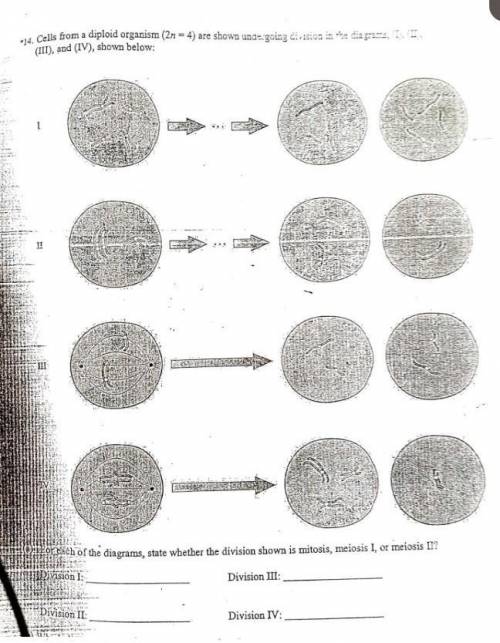
Biology, 10.03.2021 18:30 macymichtavy
Cells from a diploid organism (2n=4) are shown undergoing division in the diagrams, (I), (II), (III), and (IV), shown above.
a) For each of the diagrams, state whether the division shown is mitosis, meiosis I, or meiosis II?
i) Division I
ii) Division II
iii) Division III
iv) Division IV
b) Which diagramS show synapsed chromosomes?
c) Which of the above diagrams starts with a haploid cell?
d) In which diagram did segregation of both chromosome pairs occur?
e) What is the term that best describes the phenomenon that occured in the division of diagram IV?
I need help with this URGENTLY, PLEASE! It's not compulsory for one person to answer all the questions. But if you know the answers to all, kindly share please, please. Explanation will be highly appreciated. THANK YOU!!!


Answers: 3


Another question on Biology

Biology, 21.06.2019 15:00
Asnail, elodea (aquatic plant), or both were added to the tubes and they were stoppered. tubes were placed under a grow light for 24 hours and the results recorded. the test tubes were then covered for 24 hours to produce a dark environment and the results recorded. which statement best explains the change in test tube d from the light setup to the dark setup.
Answers: 3

Biology, 21.06.2019 20:30
Match the descriptions / definitions with the term they best describe 1. three dimensional relationship of the different polypeptide chains in a multisubunit protein or protein complex 2. common folding pattern in proteins in which a linear sequence of amino acids folds into a right-handed coil stabilized by internal hydrogen-bonding between polypeptide backbone atoms. 3. the amino acid sequence of a protein 4. a region on the surface of a protein that can interact with another molecule through noncovalent bonding. 5. three-dimensional arrangement of alpha-helices and beta-sheets within a single polypeptide, typically stabilized by a variety of noncovalent bonds, including ionic and hydrogen bonds, and nonpolar interactions / hydrophobic force. 6. the chain of repeating carbon and nitrogen atoms, linked by peptide bonds, in a protein. 7. common structural motif in proteins in which different sections of the polypeptide chain run alongside each other and are joined together by hydrogen bonding between atoms of the polypeptide backbone. 8. portion of a polypeptide chain that has a discrete tertiary structure of its own and can often fold independently of the rest of the chain 9. regular local folding patterns in a protein, including alpha-helix and beta-sheet a. primary structure b. beta-sheet c. protein d. coiled-coil e. polypeptide backbone f. secondary structure g. side chain h. tertiary structure i. binding site j. alpha-helix k. quaternary structure l. protein domain
Answers: 2

Biology, 22.06.2019 05:00
What is the farthest destination to date for a human spaceflight mission?
Answers: 1

Biology, 22.06.2019 10:30
Apopulation of rabbits live in a local forest. some had a mutation for a large body and long legs. the graph below shows the number of both the mutant and the normal rabbits over 5 generations. which of the following statements is true for this scenario? question 7 options: the rabbits with the mutation were more successful with restricted food than the normal rabbits. both sets of rabbits were equally successful with the restricted food source.i the normal rabbits were more successful with restricted food than the rabbits with the mutation. the graph does not let us know which rabbit was more successful.
Answers: 1
You know the right answer?
Cells from a diploid organism (2n=4) are shown undergoing division in the diagrams, (I), (II), (III)...
Questions

Mathematics, 15.11.2020 20:00

Mathematics, 15.11.2020 20:00

Social Studies, 15.11.2020 20:00

Physics, 15.11.2020 20:00

Mathematics, 15.11.2020 20:00





Mathematics, 15.11.2020 20:00


History, 15.11.2020 20:00

Biology, 15.11.2020 20:00

Chemistry, 15.11.2020 20:00

Mathematics, 15.11.2020 20:00


Mathematics, 15.11.2020 20:00

Advanced Placement (AP), 15.11.2020 20:00

Mathematics, 15.11.2020 20:00



